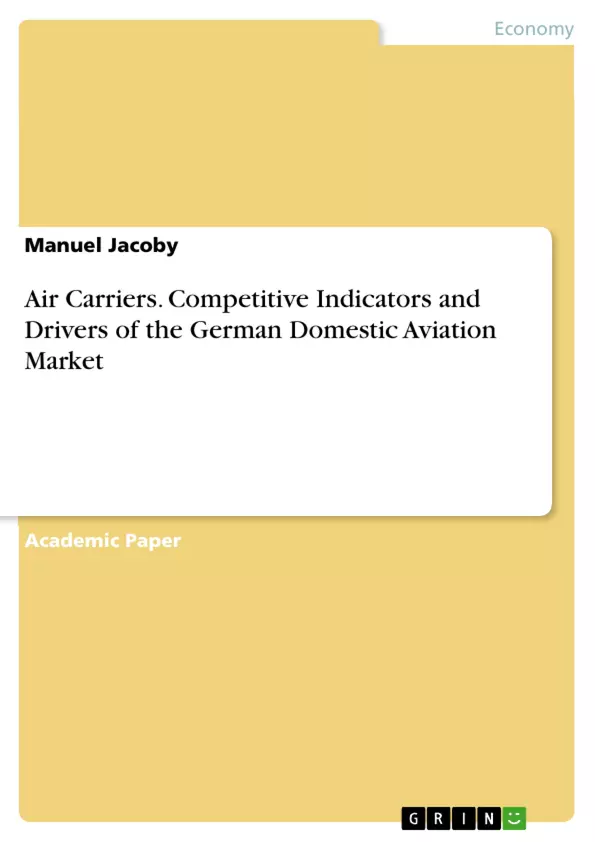This paper deals with cost drivers in the airline industry. A theoretical approach including examples is used. The objective is to gain a clear understanding of what problems airlines are facing within the industry and about the challenges they have to master concerning cost related topics. What are the key determinants behind cost related figures? This paper consists of five major parts. The first part explains the necessity of costing. Why should this topic be taken into account with regard to the airline industry? Therefore, a presentation of profitability within the industry and the significance of costing is presented. The second part demonstrates an overview of the general spreading of expenses, while the third part displays the categorization of costs. This is crucial for a clear understanding of the business; therefore, non-operating aspects have to be excluded. The last section deals with cost topics from different perspectives, such as e.g. total cost, unit cost or external cost factors. Essential matters such as the controllability of costs or BELF are additionally taken into account.
Inhaltsverzeichnis (Table of Contents)
- Executive Summary
- Introduction
- Current Profitability of Airlines
- The Significance of Costing in the Airline Industry
- The General Spreading of Costs
- Classification of Expenses
- Non-Operating and Operating Costs
- Non-Operating Cost
- Operating Cost
- Concept of Cost Escapability
- Non-Operating and Operating Costs
- Determinants of Costs
- Controllability of Costs
- Break-Even Load Factor
- Total Operating Cost and Unit Cost
- Influence of Demand
- Externally Determined Input Costs
- Fuel Prices
- Airport and En-Route Charges
- Cost of Labour
- Aircraft Type and Attributes
- Network Characteristics
- Economies of Scale, Density and Scope
- Conclusions
Zielsetzung und Themenschwerpunkte (Objectives and Key Themes)
This paper aims to provide a comprehensive understanding of the cost drivers within the airline industry. The text examines the challenges airlines face regarding cost management, the key determinants of cost-related figures, and how airlines can effectively manage expenses. It explores various cost topics, including cost classification, controllability, and the influence of demand on costs.
- Importance of Costing in the Airline Industry
- Classification and Categorization of Costs
- Determinants of Airline Costs
- Management Control and Controllability of Costs
- Economies of Scale, Density, and Scope in Aviation
Zusammenfassung der Kapitel (Chapter Summaries)
The first chapter provides an executive summary outlining the main objectives and scope of the paper. The introduction focuses on the current profitability of the airline industry, highlighting the challenges airlines face in managing costs. The paper also emphasizes the significance of costing in the airline sector, identifying key cost information elements and their importance in informed decision-making. Chapter 3 provides an overview of the general spreading of costs, highlighting dominant cost items and their distribution amongst European airlines. Chapter 4 categorizes expenses, differentiating between non-operating and operating costs and further subdividing operating costs into direct operating costs (DOC) and indirect operating costs (IOC). The concept of cost escapability is also discussed, highlighting the degree of cost avoidance in different time frames. Chapter 5 delves into the determinants of airline costs, exploring key measurement instruments such as the Break-Even Load Factor and examining the controllability of various cost items. This chapter also addresses the influence of demand and external factors like fuel prices, airport charges, and labor costs on the overall cost structure of airlines. The chapter further analyzes the impact of aircraft type, network characteristics, and the benefits of economies of scale, density, and scope.
Schlüsselwörter (Keywords)
This paper delves into the primary cost drivers in the airline industry, exploring themes such as cost controllability, cost classification, and the impact of external factors on airline expenditures. It further examines important concepts like break-even load factor, economies of scale, density, and scope. Key areas of focus include the relationship between cost management and airline profitability, strategies for cost reduction, and the importance of understanding the determinants of airline costs.
- Arbeit zitieren
- Manuel Jacoby (Autor:in), 2019, Air Carriers. Competitive Indicators and Drivers of the German Domestic Aviation Market, München, GRIN Verlag, https://www.grin.com/document/985629



